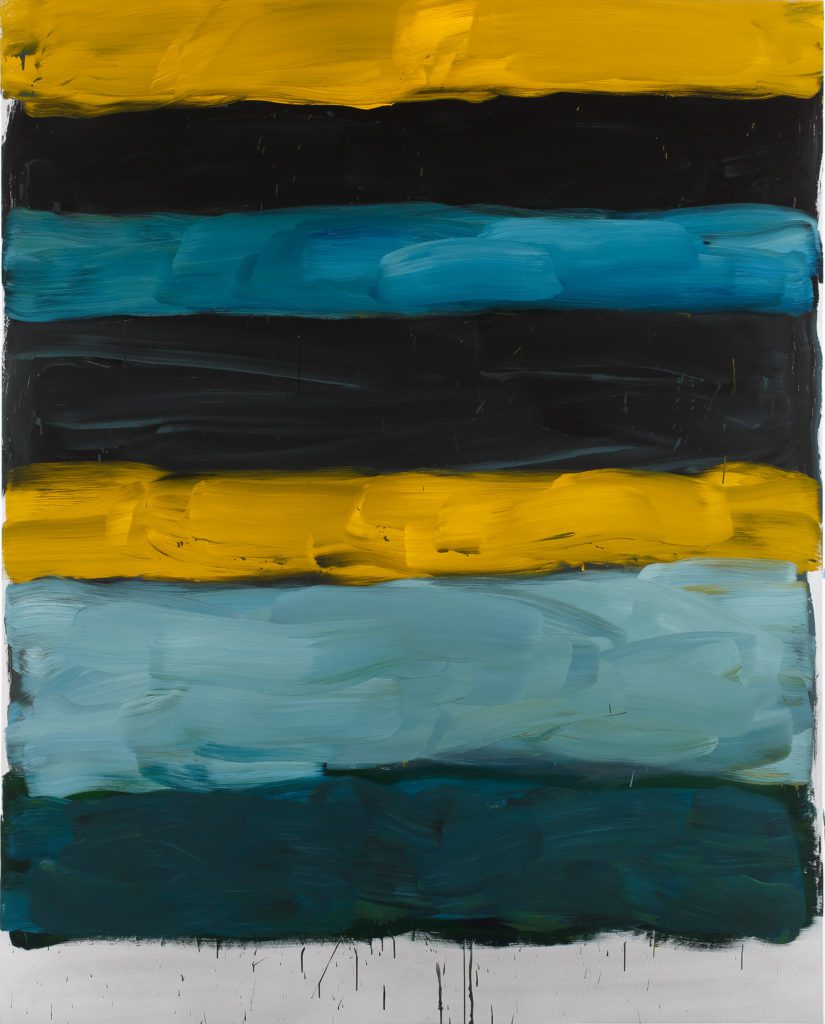Von Heyl and Scully at the Hirshhorn
By • December 4, 2018 0 747

Throughout Washington and the rest of the world, mainstream exhibitions of contemporary art are evolving toward evermore diverse forms and displays, from interactive digital exhibitions to fully immersive environments. It has become suddenly less common to see a contemporary show featuring traditional displays of painting and sculpture.
A recent visit to the Renwick’s “No Spectators: The Art of Burning Man” offered an experience more akin to Disneyland than a museum: the erratic hum of large groups in confined spaces, the frequent low-flying blitzkrieg of children, the steady clicking and traffic-jamming of selfies and photographs — all within a self-contained, cinematic world of technicolor lights and grand set pieces.
Despite my curmudgeonly tone, this is not necessarily a bad thing. The way we engage with art has been continuously shifting for centuries, with change occurring both in how art is made and how it is experienced. An interactive and inclusive approach is far more sustainable (and tolerable) than the oblique, draconian philosophies that governed so much art of the postwar era.
However, traditional art-going experiences — “looking at paintings” — have tremendous intrinsic and educative value. Like a book, a painting or sculpture offers a different kind of interaction than an interactive display, one more contained yet far less controlled, demanding a higher degree of creative agency on the part of the viewer. In a painting, your eyes are not told where to look. There is no time limit, no ending in a painting. It unfolds for each viewer at an unfixed interval, and in profoundly variant resolutions.
In museums today, in order for someone to engage with artwork in this way, they almost by necessity must turn to art of the past, finding exhibitions of dead artists who once made work to hang on walls for slow, simple, sacred observation.
This is some of what makes two of the Hirshhorn’s current exhibitions — “Charline von Heyl: Snake Eyes” (on view through Jan. 27) and “Sean Scully: Landline” (on view through Feb. 3) — so strangely exciting. Both these artists are painters. That their paintings happen to be lush, engrossing and profoundly untranslatable through photographic reproduction makes it even better.
Looking at pictures of these paintings will not give even a passing sense of their mesmerizing scale, richness and intrigue. Von Heyl and Scully are masters of their craft in very different ways; together they present a strong argument for the relevance of traditional media in contemporary art.
One of the most inventive painters working today, von Heyl — born in 1960 in Mainz, in what was then West Germany — is continually rethinking the possibilities of contemporary painting. Cerebral yet deeply, almost literally, visceral, her artworks defy traditional beauty, representation, narrative and composition, creating images that are seemingly familiar yet impossible to classify. Combining keen humor, a rigorous, process-based practice and references from a broad array of sources, von Heyl creates paintings that, in her words, offer “a new image that stands for itself as fact.”
These works are difficult to describe. Each canvas is so shape-shifting and unconventional that any effort I might focus toward discussing one painting would carry almost no representative bearing for her larger body of work. There is a faintly decipherable hieroglyphic of patterns, shapes and lines that flows through many of the pieces, while others are variations of the same composition. But within the larger schema of her work — at least inside of this exhibition — these elements function like red herrings in her audience’s search for aesthetic cohesion. Von Heyl’s paintings are like gobbets of Rauschenberg and Warhol, Futurism, Minimalism, Pop Art and a secret family spice mix, all thrown into a half-busted blender and let rip without the lid on.
Alongside von Heyl’s paintings, the work of Sean Scully, born in Dublin in 1945, could not stand in starker contrast. The Hirshhorn exhibition showcases the artist’s “Landline” series from the 56th Venice Biennale in 2015. Known for combining the geometry of European concrete art with the ethereality of American abstraction, Scully’s thick, gestural brushstrokes over grids of stripes and squares evoke the energy and beauty of the natural world. These works are largely inspired by his years in Ireland, particularly his time looking out to the sea.
The expressive bands of color walk a hazy, horizon-like line between abstraction and representation, like a low-fi James Turrell, where the contours of distant landscapes unravel to elicit a feeling that is unusually but undeniably emotional. It’s like seeing the ocean for the first time since the previous summer. The paintings quake and sway, echoing at their edges and almost glowing from within.
This “glow” is not just literary license. Painted with rich oils on copper and aluminum panels — an inspired take on the Renaissance technique of copper-plate painting, which provides a smooth surface for liquid brushstrokes — these paintings actually do shimmer. The technique allows Scully to paint with a thick, lathering delicacy, somewhere between Mark Rothko’s washes and Wayne Thiebaud’s cakes.
Do yourself a favor and go see these shows, but make sure to give yourself some time — the same amount of time you might allow yourself to tryst with the summer shore after a long winter.

